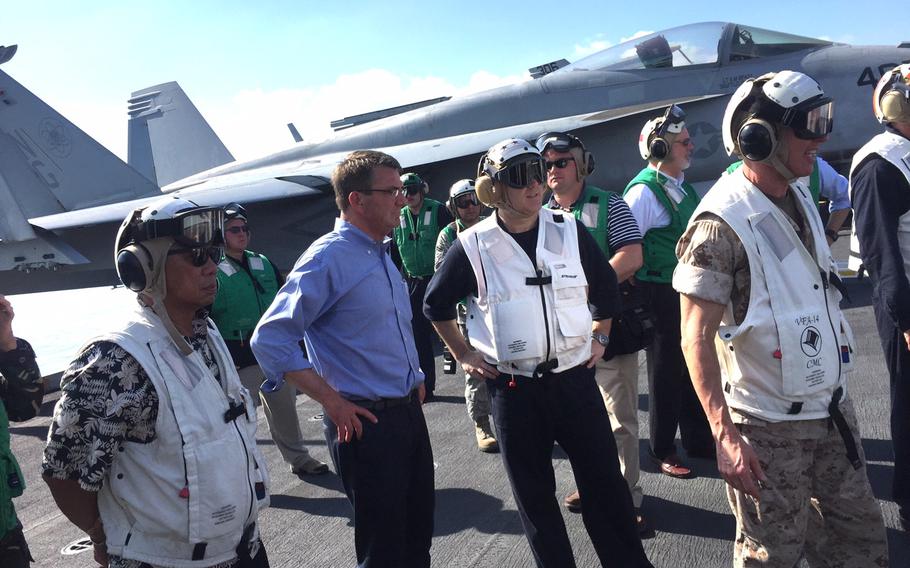
Philippines defense minister Voltaire Gazmin, far left, and U.S. Defense Secretary Ash Carter observe carrier launches of F/A-18 Super Hornets aboard the USS John C. Stennis during a sail through the South China Sea Friday, April 15, 2016. (Tara Copp/Stars and Stripes)
ABOARD THE USS JOHN C. STENNIS — U.S. Secretary of Defense Ash Carter on Friday made a second sail of the South China Sea, underscoring the U.S. commitment to its Asia-Pacific allies amid increasing tensions with China.
Carter said his presence on the aircraft carrier USS John C. Stennis, which was sailing about 60 to 70 miles West of the Philippines’ main island, Luzon Island, was to send “a message to the region.”
“The United States intends to continue to play a role in keeping peace and stability in this region’” said Carter, who was accompanied by Philippines defense minister Voltaire Gazmin.
During the two-hour sail, the defense chiefs observed take-offs and landings of U.S. F/A-18 Super Hornets and addressed a gathering of troops in the Stennis’ hangar bay.
The Stennis’ location during the patrol put it in between the Philippines and the Paracel Islands, which China has built up over the last year on natural reefs and has placed landing strips, air defense systems and advanced fighters.
The Stennis, the flagship of Carrier Strike Group 3, has been deployed to the region for the last three months, said Rear. Adm. Ron Boxall, the strike group commander.
The carrier has spent the last three weeks in the South China Sea performing routine patrols, but not the freedom-of-navigation operations that involve a U.S. vessel sailing within the 12-mile waters that border any of the Chinese-claimed man-made islands. Even so, Boxall said, the strike group has experienced “significant interaction with the Chinese navy” during its patrols.
“The Chinese navy has gotten a lot bigger,” Boxall said. “We see quite a presence out here.”
China has sharply criticized the deployment, accusing the U.S. of returning to a “Cold War” mentality and threatening to resolutely defend the reclaimed and militarized Islands, according to The Associated Press.
Carter said the idea that the U.S. was the one escalating tensions in the region was “not only incorrect, it’s backwards.”
“The only reason the question even comes up is because of what has gone on over the last year. And that is a question of Chinese behavior,” Carter said, noting that U.S. aircraft carriers have patrolled the South China Sea for decades. “What’s new is not an American carrier in this region. What’s new is the context of tension which exists, which we want to reduce.”
Carter was in the Philippines this week to meet with his defense counterparts and observe the closing ceremonies of Balikatan, an annual joint exercise involving more than 5,000 U.S. personnel. During his visit, Carter announced the U.S. would begin regular rotations to at least five Philippine bases here and leave a contingent of Marines, airmen and aircraft behind following the exercise.
Initially, U.S. forces will operate out of two additional locations, Clark Air Base and Camp Aguinaldo, Carter said Thursday. The rotations are meant to reassure the Philippines in light of China’s build-up on the islands, several of which were little more than rocks and submerged reefs before China began reclaiming the land.
“With each Balikatan and each cruise by the Stennis, with each new multilateral exercise and each new defense agreement, we add a stitch to the fabric of the region’s security network. This is the network — peaceful, principled, and inclusive — America continues to stand for, and stand with.”
Ownership of the South China Sea territories is disputed among several nations in the region. China claims about 90 percent of the sea based on historical claims, while others, including the U.S., advocate settling ownership claims based on international law.
It is Carter’s second South China Sea sail. Last fall, he boarded the aircraft carrier USS Theodore Roosevelt shortly after the destroyer USS Lassen conducted a freedom-of-navigation transit within 12 nautical miles of a China-occupied island.
copp.tara@stripes.com Twitter:@TaraCopp